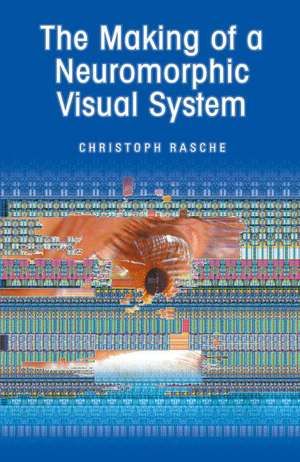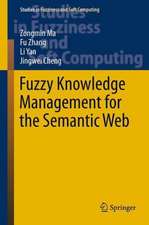The Making of a Neuromorphic Visual System
Autor Christoph Rascheen Limba Engleză Hardback – 18 noi 2004
| Toate formatele și edițiile | Preț | Express |
|---|---|---|
| Paperback (1) | 937.89 lei 6-8 săpt. | |
| Springer Us – 7 dec 2014 | 937.89 lei 6-8 săpt. | |
| Hardback (1) | 943.88 lei 6-8 săpt. | |
| Springer Us – 18 noi 2004 | 943.88 lei 6-8 săpt. |
Preț: 943.88 lei
Preț vechi: 1151.07 lei
-18% Nou
Puncte Express: 1416
Preț estimativ în valută:
180.63€ • 187.51$ • 150.62£
180.63€ • 187.51$ • 150.62£
Carte tipărită la comandă
Livrare economică 22 martie-05 aprilie
Preluare comenzi: 021 569.72.76
Specificații
ISBN-13: 9780387234687
ISBN-10: 0387234683
Pagini: 140
Ilustrații: XI, 140 p.
Dimensiuni: 155 x 235 x 11 mm
Greutate: 0.4 kg
Ediția:2005
Editura: Springer Us
Colecția Springer
Locul publicării:New York, NY, United States
ISBN-10: 0387234683
Pagini: 140
Ilustrații: XI, 140 p.
Dimensiuni: 155 x 235 x 11 mm
Greutate: 0.4 kg
Ediția:2005
Editura: Springer Us
Colecția Springer
Locul publicării:New York, NY, United States
Public țintă
ResearchCuprins
1: Seeing: Blazing Processing Characteristics1.1 An Infinite Reservoir of Information1.2 Speed 1.3 Illusions1.4 Recognition Evolvement1.5 Basic-Level Categorization1.6 Memory Capacity and Access1.7 Summary2: Category Representation and Recognition Evolvement2.1 Structural Variability Independence2.2 Viewpoint Independence2.3 Representation and Evolvement2.4 Recapitulation2.5 Refining the Primary Engineering Goal3: Neuroscientific Inspiration3.1 Hierarchy and Models3.2 Criticism and Variants3.3 Speed3.4 Alternative ‘Codes’3.5 Alternative Shape Recognition3.6 Insight from Cases of Visual Agnosia3 7 Neuronal Level3.8 Recapitulation and Conclusion4: Neuromorphic Tools4.1 The Transistor4.2 A Synaptic Circuit4.3 Dendritic Compartments4.4 An Integrate-and-Fire Neuron4.5 A Silicon Cortex4.6 Fabrication Vagrancies require Simplest Models4.7 Recapitulation5: Insight From Line Drawings Studies5.1 A Representation with Polygons 5.2 A Representation with Polygons and their Context5.3 Recapitulation6: Retina Circuits Signaling and Propagating Contours 6.1 The Input: a Luminance Landscape 6.2 Spatial Analysis in the Real Retina 6.3 The Propagation Map 6.4 Signaling Contours in Gray-Scale Images 6.5 Recapitulation7: The Symmetric-Axis Transform 7.1 The Transform 7.2 Architecture 7.3 Performance 7.4 SAT Variants 7.5 Fast Waves 7.6 Recapitulation8: Motion Detection8.1 Models8.2 Speed Detecting Architectures8.3 Simulation8.4 Biophysical Plausibility8.5 Recapitulation9: Neuromorphic Architectures: Pieces and Proposals 9.1 Integration Perspectives 9.2 Position and Size Invariance 9.3 Architecture for a Template Approach 9.4 Basic-Level Representations 9.5 Recapitulation 10: Shape Recognition with ContourPropagation Fields 10.1 The Idea of the Contour Propagation Field 10.2 Architecture 10.3 Testing 10.4 Discussion 10.5 Learning 10.6 Recapitulation 11: Scene Recognition11.1 Objects in Scenes, Scene Regularity11.2 Representation, Evolvement, Gist11.3 Scene Exploration11.4 Engineering11.5 Recapitulation12: Summary12.1 The Quest for Efficient Representation and Evolvement12.2 Contour Extraction and Grouping12.3 Neuroscientific Inspiration12.4 Neuromorphic Implementation12.5 Future ApproachTerminologyReferences IndexKeywordsAbbreviations
Recenzii
From the reviews:
"Psychologist Rasche … presents an approach to the construction of a visual system. … Past theories of visual object and shape recognition in computer vision studies are reviewed. From these studies there is proposed a completely novel shape-recognition architecture that can recognize simple shapes under various degraded situations. … Summing Up: Recommended. Graduate students through professionals, and those interested in the psychology of visual systems." (C. Tappert, CHOICE, Vol. 42 (9), May, 2005)
"Psychologist Rasche … presents an approach to the construction of a visual system. … Past theories of visual object and shape recognition in computer vision studies are reviewed. From these studies there is proposed a completely novel shape-recognition architecture that can recognize simple shapes under various degraded situations. … Summing Up: Recommended. Graduate students through professionals, and those interested in the psychology of visual systems." (C. Tappert, CHOICE, Vol. 42 (9), May, 2005)
Textul de pe ultima copertă
The reader is presented an approach to the construction of a visual system, which is behaviorally, computationally and neurally motivated. The central goal is to characterize the process of visual categorization and to find a suitable representation format that can successfully deal with the structural variability existent within visual categories. It does not define such representations a priori but attempts to show directions on how to gradually work towards them. The book reviews past and existent theories of visual object and shape recognition in the fields of computer vision, neuroscience and psychology. The entire range of computations is discussed, as for example contour extraction in retinal circuits, orientation determination in cortical networks, position and scale independence of shape, as well as the issue of object and shape representation in a neural substrate. Region-based approaches are discussed and are modeled with wave-propagating networks. It is demonstrated how those networks operate on gray-scale images. A completely novel shape recognition architecture is proposed that can recognize simple shapes under various degraded conditions. It is discussed how such networks can be used for constructing basic-level object representations. It is envisioned how those networks can be implemented using the method of neuromorphic engineering, an analog electronic hardware substrate than can run neural computations in real-time and with little power.
Caracteristici
Combines two methodologies, computer vision and neural networks as a means to find the ‘ideal’ visual representation
Makes a strong effort to develop networks that are suitable for neuromorphic hardware, a substrate that can run networks in real-time and with little power
Includes supplementary material: sn.pub/extras
Makes a strong effort to develop networks that are suitable for neuromorphic hardware, a substrate that can run networks in real-time and with little power
Includes supplementary material: sn.pub/extras


























